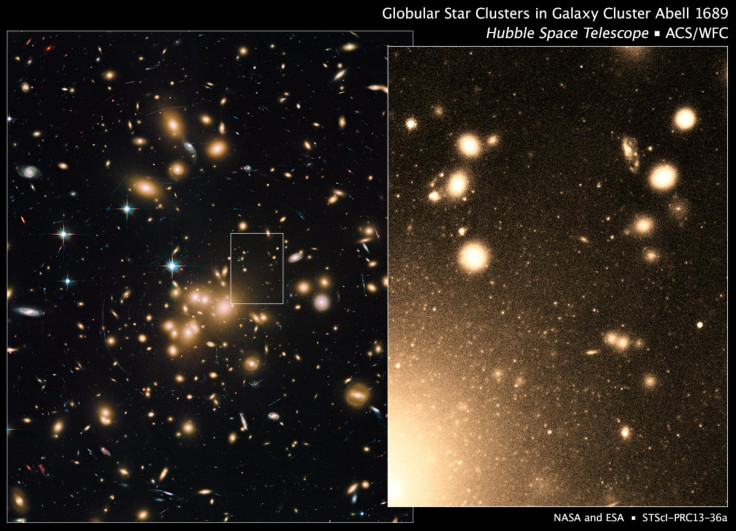NASA’s Hubble Spots Thousands Of Stars ‘Swarming Like Bees’ That May Help Trace Dark Matter

NASA’s Hubble space telescope has spotted an estimated 160,000 stars, swarming like bees inside the core of a giant group of galaxies called “Abell 1689,” scientists said on Thursday, adding that this assemblage of stars is considered to be the largest known population of globular star clusters.
Astronomers, who discovered the bunch of stars by using Hubble's Advanced Camera for Surveys, said that such compact groupings can be instrumental for tracing dark matter, the invisible gravitational scaffolding on which galaxies are built.
"We show how the relationship between globular clusters and dark matter depends on the distance from the center of the galaxy grouping," Karla Alamo-Martinez of the Center for Radio Astronomy and Astrophysics of the National Autonomous University of Mexico in Morelia, said in a statement. "In other words, if you know how many globular clusters are within a certain distance, we can give you an estimate of the amount of dark matter."
Scientists said that the globular star clusters contain some of the oldest surviving stars in the universe. According to them, almost 95 percent of globular cluster formation occurred within the first 1 billion to 2 billion years after the universe was born in the Big Bang 13.8 billion years ago.
The Hubble study, which was published online on Sept. 10 and will appear in the Sept. 20 print edition of The Astrophysical Journal, revealed that the globular star cluster in Abell 1689 is almost twice as large as any other star population found in previous surveys. In comparison, the Milky Way galaxy contains only about 150 such clusters.
In addition, the Hubble observations also revealed the distance record for the farthest distance such systems were ever studied, at 2.25 billion light-years away. According to the study, most of the globular clusters in Abell 1689 were formed near the center of the galaxy grouping, containing a deep well of dark matter. The further Hubble looks away from the core, the fewer globular clusters it detects, corresponding with a comparable drop in the amount of dark matter.
"The globular clusters are fossils of the earliest star formation in Abell 1689, and our work shows they were very efficient in forming in the denser regions of dark matter near the center of the galaxy cluster," John Blakeslee of National Research Council Canada's Herzberg Institute of Astrophysics at the Dominion Radio Astrophysical Observatory in Victoria, British Columbia, said in a statement.
While peering deep inside the heart of Abell 1689, Hubble detected a visible-light glow of 10,000 globular clusters, some as dim as the 29th magnitude, which is one-billionth the faintness of the dimmest star that people can see with the naked eye. Based on that number, Blakeslee's team estimated that more than 160,000 globular clusters are huddled within a diameter of 2.4 million light years.
© Copyright IBTimes 2024. All rights reserved.






















